Business Communication: Analyzing Price Strategies for Profitability
VerifiedAdded on 2020/03/23
|6
|1479
|50
Essay
AI Summary
This essay delves into the crucial relationship between pricing strategies and profitability in business communication. It begins by examining the traditional view that lower prices invariably lead to higher demand and revenue, while critically analyzing whether this translates to increased profits. The essay explores various pricing models, including low-price strategies, predatory pricing, and penetration pricing, discussing their potential benefits and drawbacks. It uses examples like Apple and Samsung to illustrate how premium pricing and perceived brand value can drive profitability. The essay also addresses the negative impact of low prices on consumer perception and brand quality, highlighting the importance of product differentiation and justifying premium prices through high-quality offerings. Ultimately, the essay emphasizes that while lower prices may boost sales in the short term, they don't always guarantee higher profit margins, and the long-term success of a business depends on a well-considered pricing strategy that considers market dynamics, consumer behavior, and brand perception.
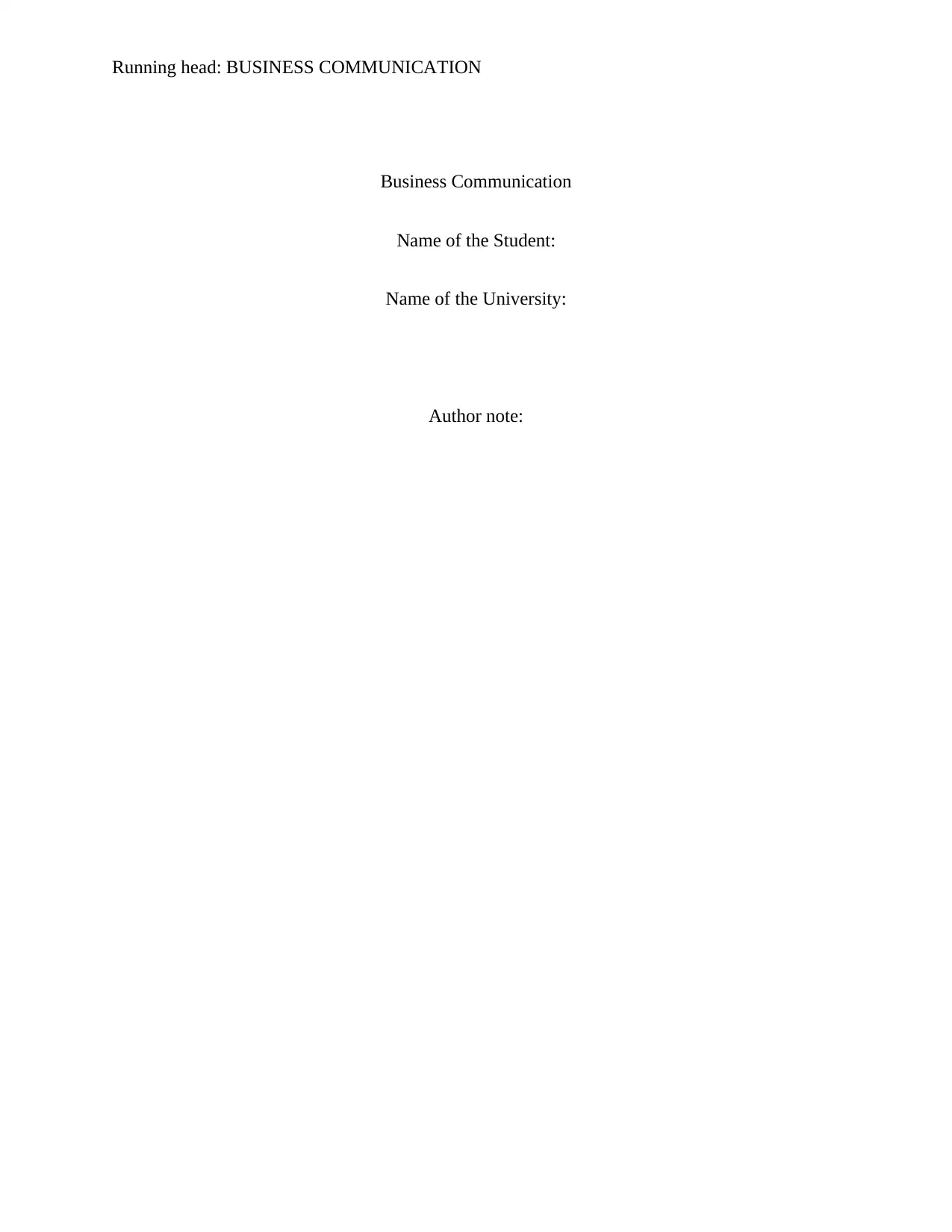
Running head: BUSINESS COMMUNICATION
Business Communication
Name of the Student:
Name of the University:
Author note:
Business Communication
Name of the Student:
Name of the University:
Author note:
Paraphrase This Document
Need a fresh take? Get an instant paraphrase of this document with our AI Paraphraser
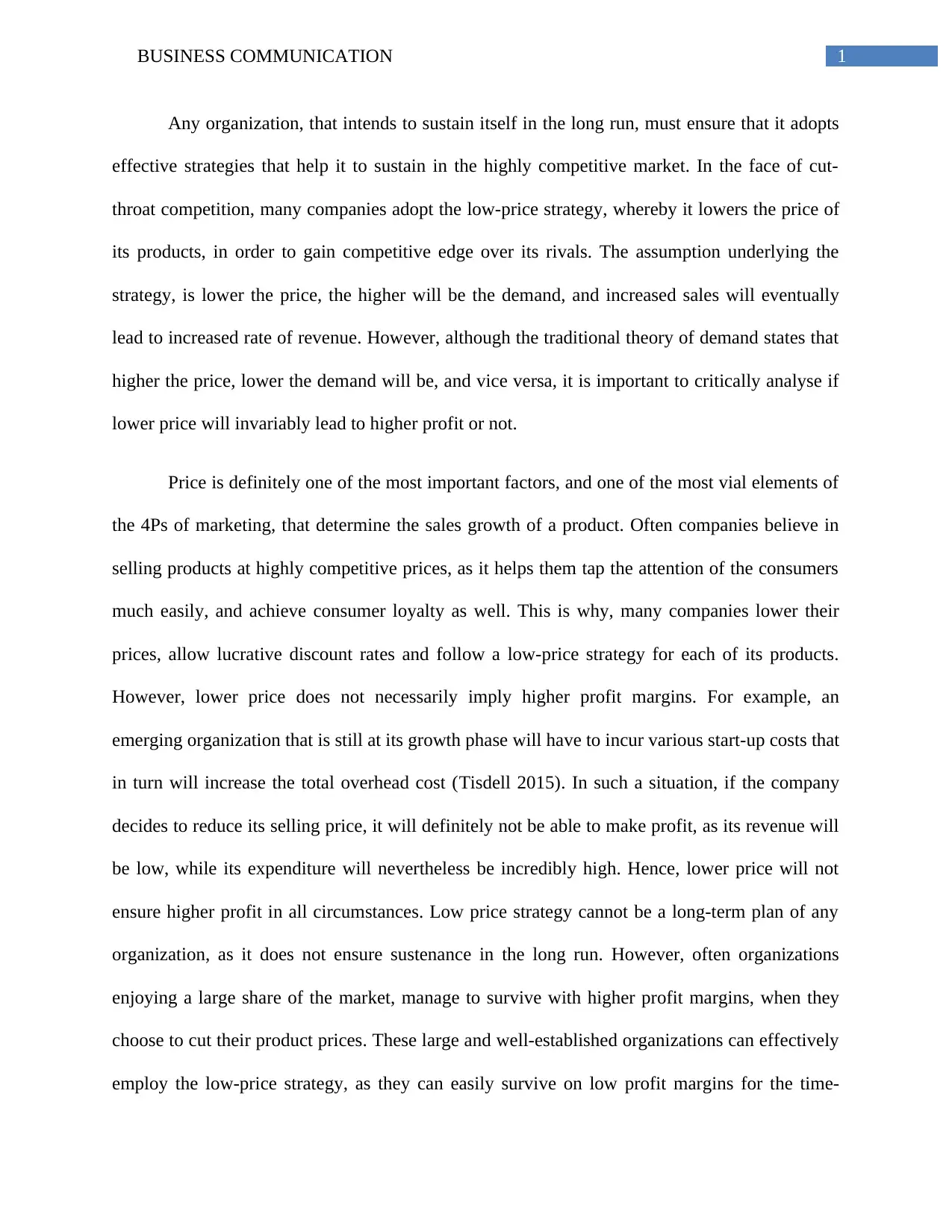
1BUSINESS COMMUNICATION
Any organization, that intends to sustain itself in the long run, must ensure that it adopts
effective strategies that help it to sustain in the highly competitive market. In the face of cut-
throat competition, many companies adopt the low-price strategy, whereby it lowers the price of
its products, in order to gain competitive edge over its rivals. The assumption underlying the
strategy, is lower the price, the higher will be the demand, and increased sales will eventually
lead to increased rate of revenue. However, although the traditional theory of demand states that
higher the price, lower the demand will be, and vice versa, it is important to critically analyse if
lower price will invariably lead to higher profit or not.
Price is definitely one of the most important factors, and one of the most vial elements of
the 4Ps of marketing, that determine the sales growth of a product. Often companies believe in
selling products at highly competitive prices, as it helps them tap the attention of the consumers
much easily, and achieve consumer loyalty as well. This is why, many companies lower their
prices, allow lucrative discount rates and follow a low-price strategy for each of its products.
However, lower price does not necessarily imply higher profit margins. For example, an
emerging organization that is still at its growth phase will have to incur various start-up costs that
in turn will increase the total overhead cost (Tisdell 2015). In such a situation, if the company
decides to reduce its selling price, it will definitely not be able to make profit, as its revenue will
be low, while its expenditure will nevertheless be incredibly high. Hence, lower price will not
ensure higher profit in all circumstances. Low price strategy cannot be a long-term plan of any
organization, as it does not ensure sustenance in the long run. However, often organizations
enjoying a large share of the market, manage to survive with higher profit margins, when they
choose to cut their product prices. These large and well-established organizations can effectively
employ the low-price strategy, as they can easily survive on low profit margins for the time-
Any organization, that intends to sustain itself in the long run, must ensure that it adopts
effective strategies that help it to sustain in the highly competitive market. In the face of cut-
throat competition, many companies adopt the low-price strategy, whereby it lowers the price of
its products, in order to gain competitive edge over its rivals. The assumption underlying the
strategy, is lower the price, the higher will be the demand, and increased sales will eventually
lead to increased rate of revenue. However, although the traditional theory of demand states that
higher the price, lower the demand will be, and vice versa, it is important to critically analyse if
lower price will invariably lead to higher profit or not.
Price is definitely one of the most important factors, and one of the most vial elements of
the 4Ps of marketing, that determine the sales growth of a product. Often companies believe in
selling products at highly competitive prices, as it helps them tap the attention of the consumers
much easily, and achieve consumer loyalty as well. This is why, many companies lower their
prices, allow lucrative discount rates and follow a low-price strategy for each of its products.
However, lower price does not necessarily imply higher profit margins. For example, an
emerging organization that is still at its growth phase will have to incur various start-up costs that
in turn will increase the total overhead cost (Tisdell 2015). In such a situation, if the company
decides to reduce its selling price, it will definitely not be able to make profit, as its revenue will
be low, while its expenditure will nevertheless be incredibly high. Hence, lower price will not
ensure higher profit in all circumstances. Low price strategy cannot be a long-term plan of any
organization, as it does not ensure sustenance in the long run. However, often organizations
enjoying a large share of the market, manage to survive with higher profit margins, when they
choose to cut their product prices. These large and well-established organizations can effectively
employ the low-price strategy, as they can easily survive on low profit margins for the time-
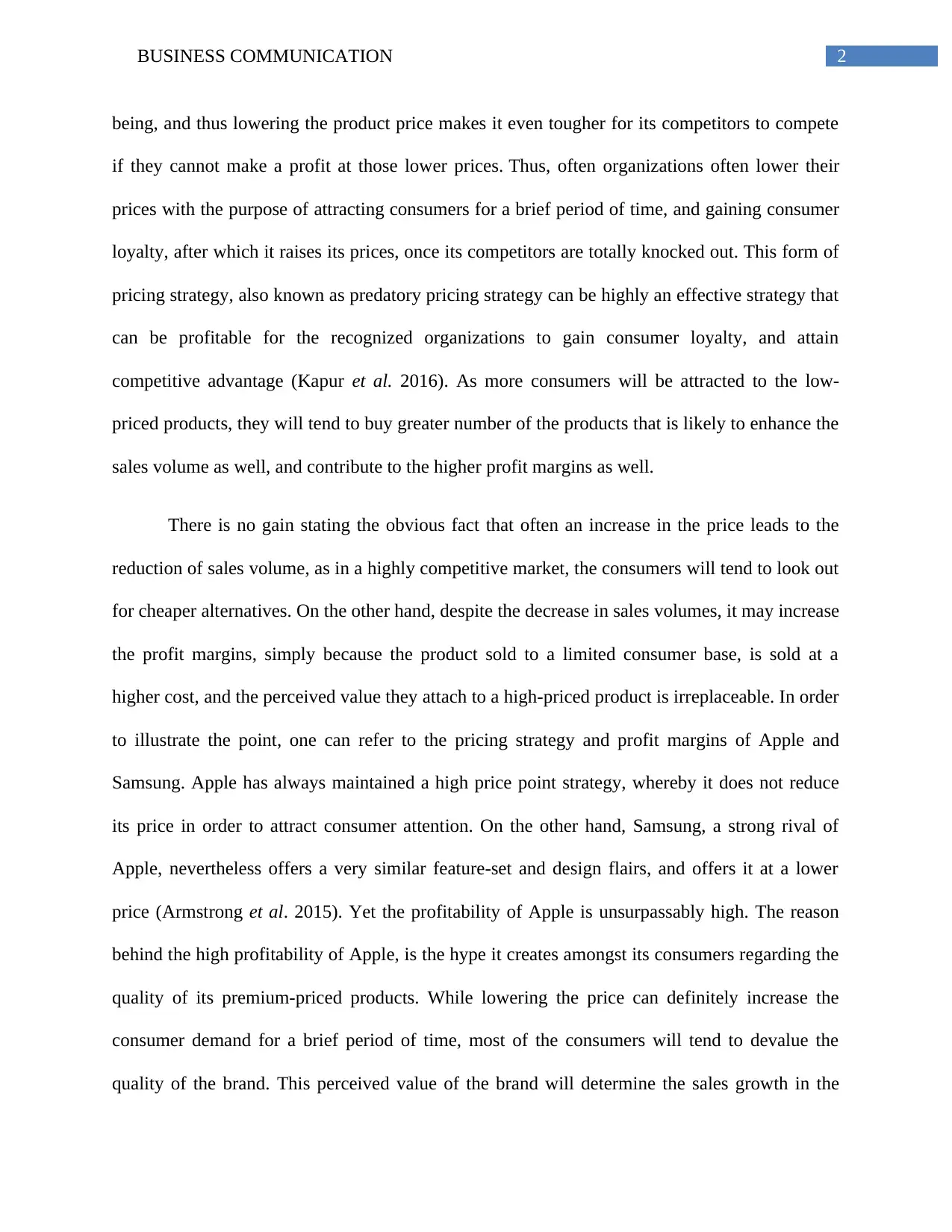
2BUSINESS COMMUNICATION
being, and thus lowering the product price makes it even tougher for its competitors to compete
if they cannot make a profit at those lower prices. Thus, often organizations often lower their
prices with the purpose of attracting consumers for a brief period of time, and gaining consumer
loyalty, after which it raises its prices, once its competitors are totally knocked out. This form of
pricing strategy, also known as predatory pricing strategy can be highly an effective strategy that
can be profitable for the recognized organizations to gain consumer loyalty, and attain
competitive advantage (Kapur et al. 2016). As more consumers will be attracted to the low-
priced products, they will tend to buy greater number of the products that is likely to enhance the
sales volume as well, and contribute to the higher profit margins as well.
There is no gain stating the obvious fact that often an increase in the price leads to the
reduction of sales volume, as in a highly competitive market, the consumers will tend to look out
for cheaper alternatives. On the other hand, despite the decrease in sales volumes, it may increase
the profit margins, simply because the product sold to a limited consumer base, is sold at a
higher cost, and the perceived value they attach to a high-priced product is irreplaceable. In order
to illustrate the point, one can refer to the pricing strategy and profit margins of Apple and
Samsung. Apple has always maintained a high price point strategy, whereby it does not reduce
its price in order to attract consumer attention. On the other hand, Samsung, a strong rival of
Apple, nevertheless offers a very similar feature-set and design flairs, and offers it at a lower
price (Armstrong et al. 2015). Yet the profitability of Apple is unsurpassably high. The reason
behind the high profitability of Apple, is the hype it creates amongst its consumers regarding the
quality of its premium-priced products. While lowering the price can definitely increase the
consumer demand for a brief period of time, most of the consumers will tend to devalue the
quality of the brand. This perceived value of the brand will determine the sales growth in the
being, and thus lowering the product price makes it even tougher for its competitors to compete
if they cannot make a profit at those lower prices. Thus, often organizations often lower their
prices with the purpose of attracting consumers for a brief period of time, and gaining consumer
loyalty, after which it raises its prices, once its competitors are totally knocked out. This form of
pricing strategy, also known as predatory pricing strategy can be highly an effective strategy that
can be profitable for the recognized organizations to gain consumer loyalty, and attain
competitive advantage (Kapur et al. 2016). As more consumers will be attracted to the low-
priced products, they will tend to buy greater number of the products that is likely to enhance the
sales volume as well, and contribute to the higher profit margins as well.
There is no gain stating the obvious fact that often an increase in the price leads to the
reduction of sales volume, as in a highly competitive market, the consumers will tend to look out
for cheaper alternatives. On the other hand, despite the decrease in sales volumes, it may increase
the profit margins, simply because the product sold to a limited consumer base, is sold at a
higher cost, and the perceived value they attach to a high-priced product is irreplaceable. In order
to illustrate the point, one can refer to the pricing strategy and profit margins of Apple and
Samsung. Apple has always maintained a high price point strategy, whereby it does not reduce
its price in order to attract consumer attention. On the other hand, Samsung, a strong rival of
Apple, nevertheless offers a very similar feature-set and design flairs, and offers it at a lower
price (Armstrong et al. 2015). Yet the profitability of Apple is unsurpassably high. The reason
behind the high profitability of Apple, is the hype it creates amongst its consumers regarding the
quality of its premium-priced products. While lowering the price can definitely increase the
consumer demand for a brief period of time, most of the consumers will tend to devalue the
quality of the brand. This perceived value of the brand will determine the sales growth in the
⊘ This is a preview!⊘
Do you want full access?
Subscribe today to unlock all pages.

Trusted by 1+ million students worldwide
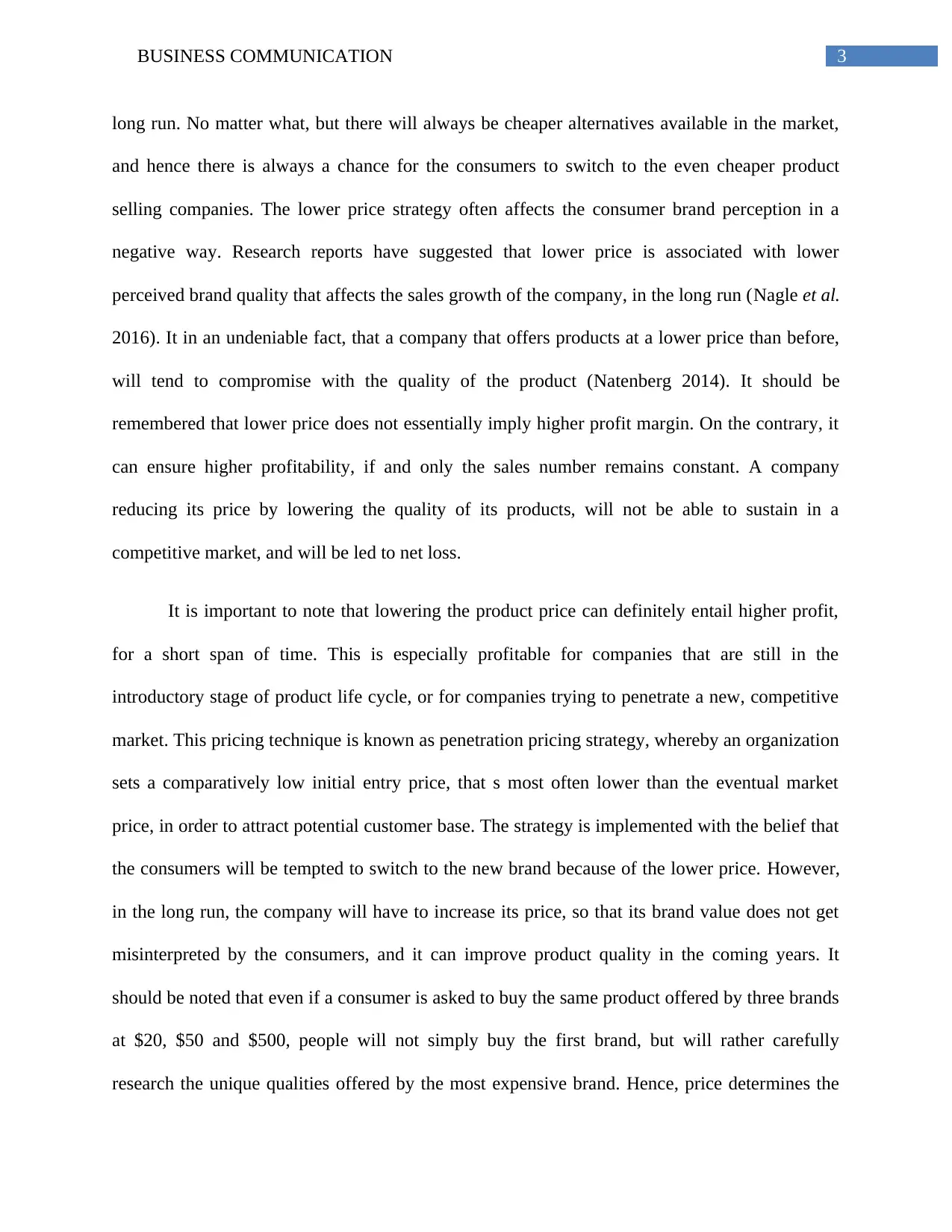
3BUSINESS COMMUNICATION
long run. No matter what, but there will always be cheaper alternatives available in the market,
and hence there is always a chance for the consumers to switch to the even cheaper product
selling companies. The lower price strategy often affects the consumer brand perception in a
negative way. Research reports have suggested that lower price is associated with lower
perceived brand quality that affects the sales growth of the company, in the long run (Nagle et al.
2016). It in an undeniable fact, that a company that offers products at a lower price than before,
will tend to compromise with the quality of the product (Natenberg 2014). It should be
remembered that lower price does not essentially imply higher profit margin. On the contrary, it
can ensure higher profitability, if and only the sales number remains constant. A company
reducing its price by lowering the quality of its products, will not be able to sustain in a
competitive market, and will be led to net loss.
It is important to note that lowering the product price can definitely entail higher profit,
for a short span of time. This is especially profitable for companies that are still in the
introductory stage of product life cycle, or for companies trying to penetrate a new, competitive
market. This pricing technique is known as penetration pricing strategy, whereby an organization
sets a comparatively low initial entry price, that s most often lower than the eventual market
price, in order to attract potential customer base. The strategy is implemented with the belief that
the consumers will be tempted to switch to the new brand because of the lower price. However,
in the long run, the company will have to increase its price, so that its brand value does not get
misinterpreted by the consumers, and it can improve product quality in the coming years. It
should be noted that even if a consumer is asked to buy the same product offered by three brands
at $20, $50 and $500, people will not simply buy the first brand, but will rather carefully
research the unique qualities offered by the most expensive brand. Hence, price determines the
long run. No matter what, but there will always be cheaper alternatives available in the market,
and hence there is always a chance for the consumers to switch to the even cheaper product
selling companies. The lower price strategy often affects the consumer brand perception in a
negative way. Research reports have suggested that lower price is associated with lower
perceived brand quality that affects the sales growth of the company, in the long run (Nagle et al.
2016). It in an undeniable fact, that a company that offers products at a lower price than before,
will tend to compromise with the quality of the product (Natenberg 2014). It should be
remembered that lower price does not essentially imply higher profit margin. On the contrary, it
can ensure higher profitability, if and only the sales number remains constant. A company
reducing its price by lowering the quality of its products, will not be able to sustain in a
competitive market, and will be led to net loss.
It is important to note that lowering the product price can definitely entail higher profit,
for a short span of time. This is especially profitable for companies that are still in the
introductory stage of product life cycle, or for companies trying to penetrate a new, competitive
market. This pricing technique is known as penetration pricing strategy, whereby an organization
sets a comparatively low initial entry price, that s most often lower than the eventual market
price, in order to attract potential customer base. The strategy is implemented with the belief that
the consumers will be tempted to switch to the new brand because of the lower price. However,
in the long run, the company will have to increase its price, so that its brand value does not get
misinterpreted by the consumers, and it can improve product quality in the coming years. It
should be noted that even if a consumer is asked to buy the same product offered by three brands
at $20, $50 and $500, people will not simply buy the first brand, but will rather carefully
research the unique qualities offered by the most expensive brand. Hence, price determines the
Paraphrase This Document
Need a fresh take? Get an instant paraphrase of this document with our AI Paraphraser
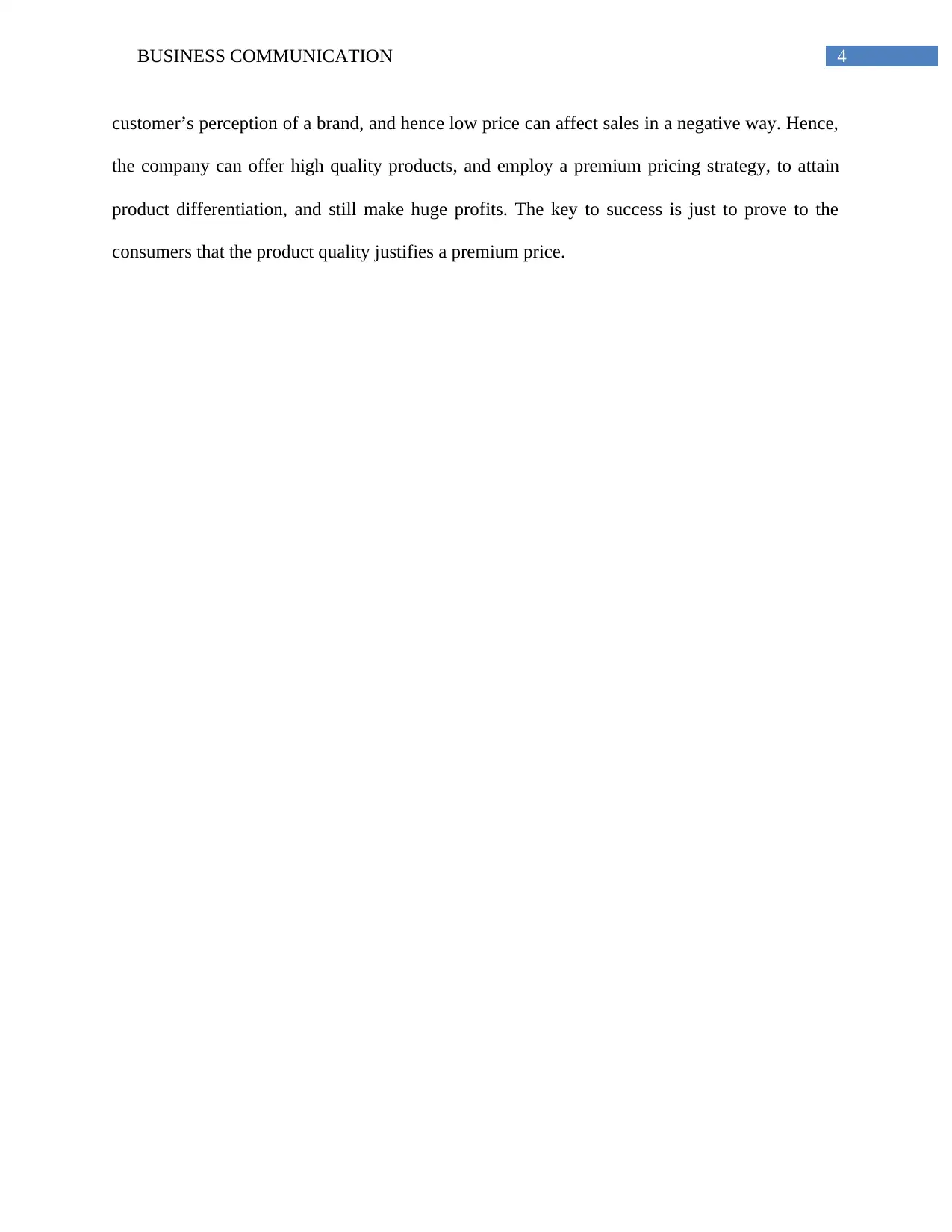
4BUSINESS COMMUNICATION
customer’s perception of a brand, and hence low price can affect sales in a negative way. Hence,
the company can offer high quality products, and employ a premium pricing strategy, to attain
product differentiation, and still make huge profits. The key to success is just to prove to the
consumers that the product quality justifies a premium price.
customer’s perception of a brand, and hence low price can affect sales in a negative way. Hence,
the company can offer high quality products, and employ a premium pricing strategy, to attain
product differentiation, and still make huge profits. The key to success is just to prove to the
consumers that the product quality justifies a premium price.
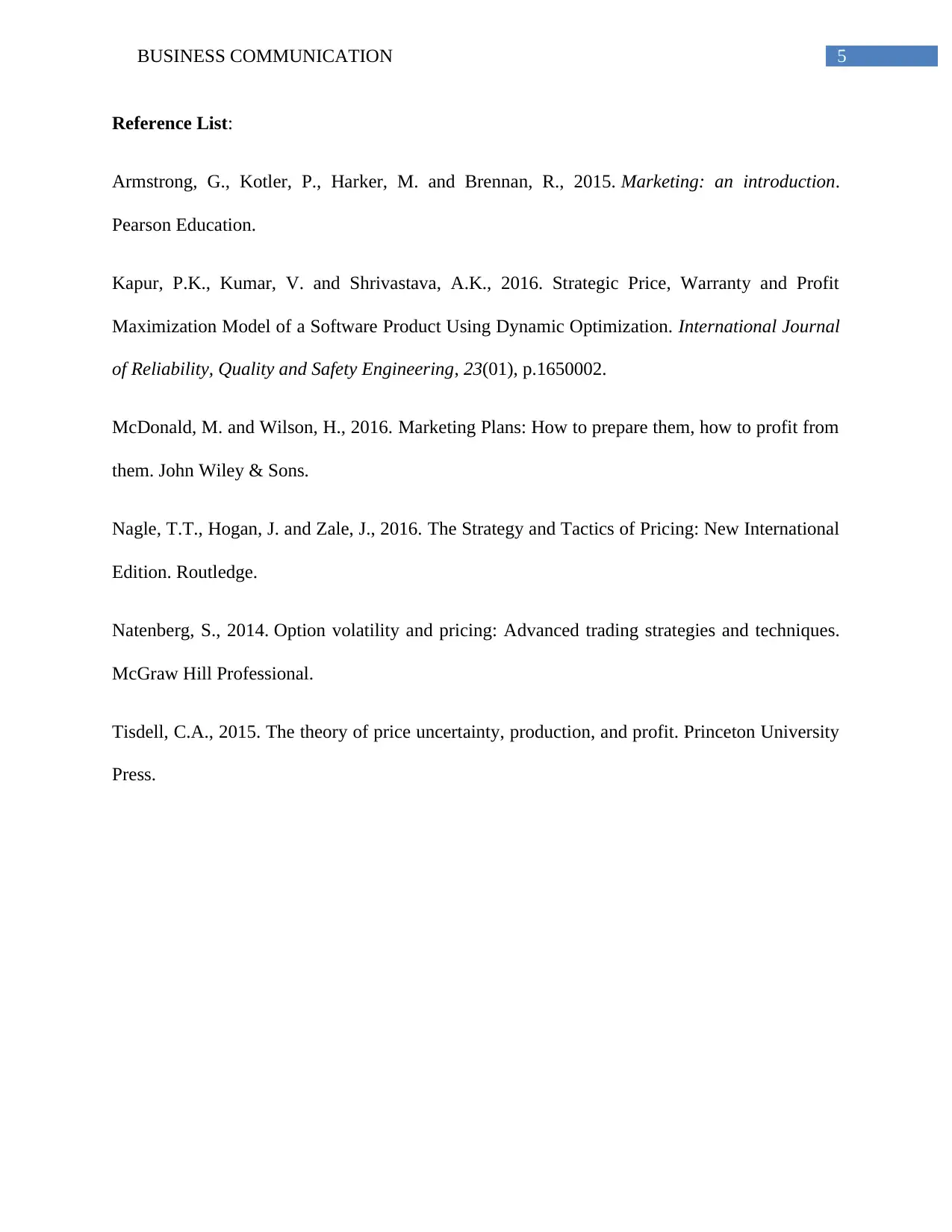
5BUSINESS COMMUNICATION
Reference List:
Armstrong, G., Kotler, P., Harker, M. and Brennan, R., 2015. Marketing: an introduction.
Pearson Education.
Kapur, P.K., Kumar, V. and Shrivastava, A.K., 2016. Strategic Price, Warranty and Profit
Maximization Model of a Software Product Using Dynamic Optimization. International Journal
of Reliability, Quality and Safety Engineering, 23(01), p.1650002.
McDonald, M. and Wilson, H., 2016. Marketing Plans: How to prepare them, how to profit from
them. John Wiley & Sons.
Nagle, T.T., Hogan, J. and Zale, J., 2016. The Strategy and Tactics of Pricing: New International
Edition. Routledge.
Natenberg, S., 2014. Option volatility and pricing: Advanced trading strategies and techniques.
McGraw Hill Professional.
Tisdell, C.A., 2015. The theory of price uncertainty, production, and profit. Princeton University
Press.
Reference List:
Armstrong, G., Kotler, P., Harker, M. and Brennan, R., 2015. Marketing: an introduction.
Pearson Education.
Kapur, P.K., Kumar, V. and Shrivastava, A.K., 2016. Strategic Price, Warranty and Profit
Maximization Model of a Software Product Using Dynamic Optimization. International Journal
of Reliability, Quality and Safety Engineering, 23(01), p.1650002.
McDonald, M. and Wilson, H., 2016. Marketing Plans: How to prepare them, how to profit from
them. John Wiley & Sons.
Nagle, T.T., Hogan, J. and Zale, J., 2016. The Strategy and Tactics of Pricing: New International
Edition. Routledge.
Natenberg, S., 2014. Option volatility and pricing: Advanced trading strategies and techniques.
McGraw Hill Professional.
Tisdell, C.A., 2015. The theory of price uncertainty, production, and profit. Princeton University
Press.
⊘ This is a preview!⊘
Do you want full access?
Subscribe today to unlock all pages.

Trusted by 1+ million students worldwide
1 out of 6
Related Documents
Your All-in-One AI-Powered Toolkit for Academic Success.
+13062052269
info@desklib.com
Available 24*7 on WhatsApp / Email
![[object Object]](/_next/static/media/star-bottom.7253800d.svg)
Unlock your academic potential
Copyright © 2020–2025 A2Z Services. All Rights Reserved. Developed and managed by ZUCOL.





